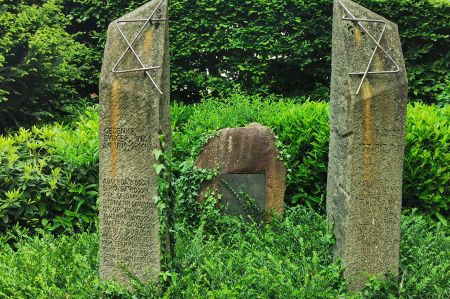Tour of Dülmen – Wiesmann Roadster in memory
- Written by Portal Editor
It's been years since we were last in Dülmen, the time to extensively visit the excellent, universal leather tailoring of the Wiesmann brothers' sports car manufacturer, and of course the sports car manufacturer itself for an arranged test drive of an MF2X.
But more on that later.
Nonnenturm, Lorenkenturm and the Lüdinghauser Tor
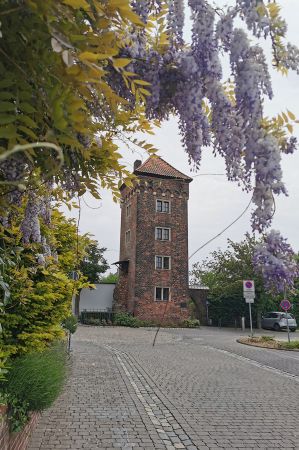 We begin today's tour at the Nonnengasse car park and stand directly in front of the so-called Nonnenturm, through whose clinker gate we reach Probst-Dümpelmann-Weg. Along with the Lorenkenturm and the Lüdinghauser Tor, Nonnenturm is one of three surviving parts of the former city fortifications of Dülmen. The tower with a square floor plan still shows the remains of the Dülmen city wall on its side. The nunnery is the last of the formerly triangular towers of the old fortification. The now four-storey tower dates from the 16th century and was originally used as a powder tower. The city fortifications gradually fell into disrepair in the middle of the 17th century. The tower came into private ownership in 1730 and changed hands several times. In 1953 the tower was rebuilt in modified form. The inside of the tower is now part of a dwelling. The nuns' tower was last renovated in 1982. The name of the tower refers to the nearby and now closed Augustinian nunnery called Agnetenberg, whose best-known convent member was Anna Katharina Emmerick (more on that later).
We begin today's tour at the Nonnengasse car park and stand directly in front of the so-called Nonnenturm, through whose clinker gate we reach Probst-Dümpelmann-Weg. Along with the Lorenkenturm and the Lüdinghauser Tor, Nonnenturm is one of three surviving parts of the former city fortifications of Dülmen. The tower with a square floor plan still shows the remains of the Dülmen city wall on its side. The nunnery is the last of the formerly triangular towers of the old fortification. The now four-storey tower dates from the 16th century and was originally used as a powder tower. The city fortifications gradually fell into disrepair in the middle of the 17th century. The tower came into private ownership in 1730 and changed hands several times. In 1953 the tower was rebuilt in modified form. The inside of the tower is now part of a dwelling. The nuns' tower was last renovated in 1982. The name of the tower refers to the nearby and now closed Augustinian nunnery called Agnetenberg, whose best-known convent member was Anna Katharina Emmerick (more on that later).
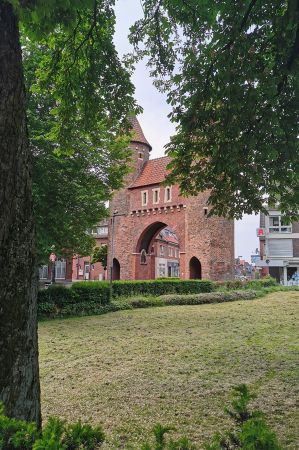 In general, only the Lüdinghauser Tor, which is also Dülmen's landmark, and the Lorenkenturm are preserved from the old city fortifications of Dülmen, which once included five gates and at least four towers. The other, former city gates (Münstertor, Burgtor, Neues Tor and Coesfelder Tor) are only reflected in the names of a few restaurants or streets. Buddenturm and Tiberturm have not survived.
In general, only the Lüdinghauser Tor, which is also Dülmen's landmark, and the Lorenkenturm are preserved from the old city fortifications of Dülmen, which once included five gates and at least four towers. The other, former city gates (Münstertor, Burgtor, Neues Tor and Coesfelder Tor) are only reflected in the names of a few restaurants or streets. Buddenturm and Tiberturm have not survived.
The oldest surviving buildings also include the oldest church in Dülmen, St. Viktor, which was founded in 780 and is named after Viktor von Xanten.
Via the Nonnenwall we reach the former Jewish cemetery, where today a memorial commemorates the pogroms of the Nazi era. Lüdinghauser Tor can already be seen in the background. The gate (or Lüdinghauser Pforte or Ludinchuser Porten) was probably built in the 14th century as a wooden gate as part of the city fortifications.
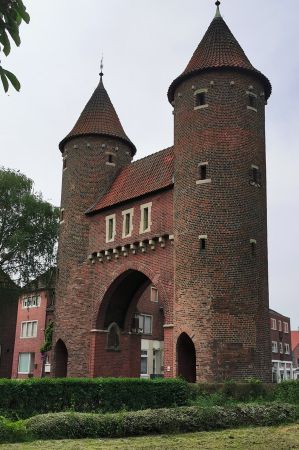 The stone towers were built at the end of the 15th century, with a wooden battlement serving as a connection. Artillery pieces were erected at the gates and walls, two of which stood at Lüdinghauser Tor from 1584. The battlements and the gate building that had been erected in the meantime disappeared over time. The gatehouse was demolished in 1836 when road tolls were banned. Until 1906, one of the towers also served as a city prison. The towers of the Lüdinghauser Tor were considered a traffic obstacle as early as the mid-19th century, but the government forbade their demolition.
The stone towers were built at the end of the 15th century, with a wooden battlement serving as a connection. Artillery pieces were erected at the gates and walls, two of which stood at Lüdinghauser Tor from 1584. The battlements and the gate building that had been erected in the meantime disappeared over time. The gatehouse was demolished in 1836 when road tolls were banned. Until 1906, one of the towers also served as a city prison. The towers of the Lüdinghauser Tor were considered a traffic obstacle as early as the mid-19th century, but the government forbade their demolition.
In the course of the ban, a pedestrian passage was broken first in the western and later in the eastern tower. In 1908, as part of the preparations for the 600th anniversary of the city in 1911, the two towers were re-roofed and the stone connection was built as a characteristic central building.
Holy Cross Church and Anna Katharina Emmerick
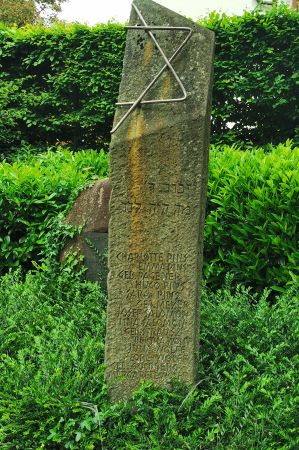 We continue our way along Lüdinghauser Strasse and reach the Heilig-Kreuz-Kirche, which was built between 1936 and 1938. The Heilig-Kreuz-Kirche was built by the master builder Dominikus Böhm as the second Catholic parish church in the city against much resistance and inaugurated by the then Bishop of Münster Clemens August Graf von Galen as the last new church to be built in Germany before the Second World War on November 16, 1938.
We continue our way along Lüdinghauser Strasse and reach the Heilig-Kreuz-Kirche, which was built between 1936 and 1938. The Heilig-Kreuz-Kirche was built by the master builder Dominikus Böhm as the second Catholic parish church in the city against much resistance and inaugurated by the then Bishop of Münster Clemens August Graf von Galen as the last new church to be built in Germany before the Second World War on November 16, 1938.
On October 4, 1936, Dominikus Böhm received the order to build a parish church that would also serve as a burial and pilgrimage church for Anna Katharina Emmerick. On March 22, 1945, the church was destroyed by bombs, with the exception of the chancel and tower. The reconstruction of the building took place until 1953, the baptistery was not rebuilt. The entrance area was also changed, instead of the previous five entrance doors, it was reduced to three portals. The church was extensively renovated in the years 1971 to 1974 and renovated and redesigned in 2004 to 2005 by the architects Feja and Kemper. During the redesign, the altar was moved to the middle.
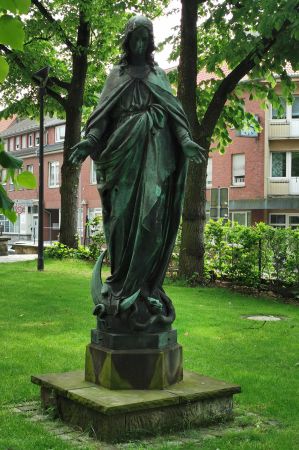 The bones of Anna Katharina Emmerick were reburied in 1975 after the resumption of her beatification process from the neighbouring cemetery, where she was buried in 1824, into the crypt of the church. After the beatification in 2004, the tomb was redesigned and the Anna Catherine Emmerick memorial was set up under the crypt. There you can u. the sick room can be visited, which was removed from the now demolished house of the Limberg inn in 1899 and was preserved in its original condition together with the furnishings.
The bones of Anna Katharina Emmerick were reburied in 1975 after the resumption of her beatification process from the neighbouring cemetery, where she was buried in 1824, into the crypt of the church. After the beatification in 2004, the tomb was redesigned and the Anna Catherine Emmerick memorial was set up under the crypt. There you can u. the sick room can be visited, which was removed from the now demolished house of the Limberg inn in 1899 and was preserved in its original condition together with the furnishings.
We continue on our way and get to the castle park, which we cross along the pond. The castle was located at the point where today's Halterner Strasse leads into the city centre of Dülmen. Initially, the dukes resided in various town houses until they acquired the Dolhofen property on Burgstrasse. The area was expanded beyond the medieval city limits. The construction of the palace in Empire style began in 1834, when Duke Alfred von Croÿ laid the foundation stone. The first drafts went back to a nephew, but the final design of the neoclassical facade was the responsibility of the Milanese architect Brey. With the completion in 1844, the planning for the design of the castle garden with boiler house and glass greenhouses was carried out by Schinkel's student August Stüler. In 1861 the castle garden was transformed into a landscape garden. A monumental arch was built on the forecourt. During the Second World War, the castle was destroyed in 1945 and never rebuilt.
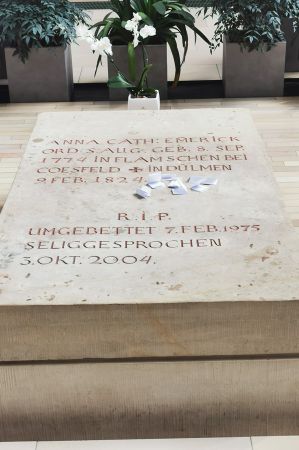 Only the coach house and parts of the terrace have been preserved. They were demolished in 2006 with the construction of a shopping centre and a parking lot. Since 1836, Haus Merfeld has belonged to the ducal estate, to which the residence was transferred in 1945, as well as Schweckhausen Palace from 1847 to 2015.
Only the coach house and parts of the terrace have been preserved. They were demolished in 2006 with the construction of a shopping centre and a parking lot. Since 1836, Haus Merfeld has belonged to the ducal estate, to which the residence was transferred in 1945, as well as Schweckhausen Palace from 1847 to 2015.
We return to the city centre and enjoy the wonderful sun in a café at the market. The many cyclists who probably had similar thoughts are striking, because Dülmen has a large network of cycle paths, which makes it a destination especially for the nearby Ruhr area. Also striking is the term "wild horses", which appears again and again, whether as the name of a hotel, a restaurant, a street or .... We will learn more.
Please read more:
Lucky Troubles – Blues during Caravaning Festival Warsaw
Excavations in Siculi - Magna Grecia Part 2
-
 Hiking the Citycenter of Duelmen
Hiking the Citycenter of Duelmen
Hiking the Citycenter of Duelmen
Hiking the Citycenter of Duelmen
-
 Hiking the Citycenter of Duelmen
Hiking the Citycenter of Duelmen
Hiking the Citycenter of Duelmen
Hiking the Citycenter of Duelmen
-
 Hiking the Citycenter of Duelmen
Hiking the Citycenter of Duelmen
Hiking the Citycenter of Duelmen
Hiking the Citycenter of Duelmen
-
 Hiking the Citycenter of Duelmen
Hiking the Citycenter of Duelmen
Hiking the Citycenter of Duelmen
Hiking the Citycenter of Duelmen
-
 Hiking the Citycenter of Duelmen
Hiking the Citycenter of Duelmen
Hiking the Citycenter of Duelmen
Hiking the Citycenter of Duelmen
-
 Hiking the Citycenter of Duelmen
Hiking the Citycenter of Duelmen
Hiking the Citycenter of Duelmen
Hiking the Citycenter of Duelmen
https://www.alaturka.info/en/germany/north-rhine-westphalia/6144-tour-of-duelmen-wiesmann-roadster-in-memory#sigProId8f88998ec2
